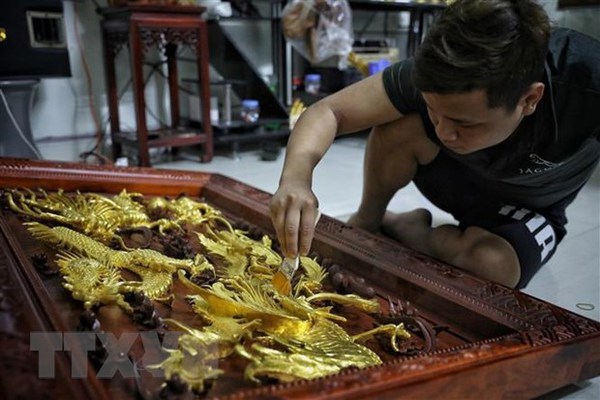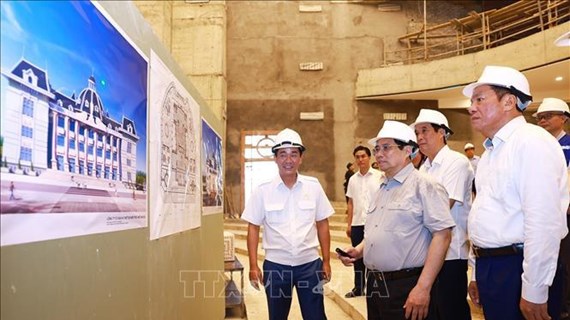Craft villages in Hanoi resume production
 Phu Tuc grass weaving village in Phu Xuyen district. (Photo: vov.vn)
Phu Tuc grass weaving village in Phu Xuyen district. (Photo: vov.vn)Hanoi (VNA) – As social distancing measures have been eased in Hanoi since September 15, production facilities in local craft villages have begun preparing for the restoration of production after being standstill for a long period. However, craft villages still face many difficulties and need more support from local authorities and relevant agencies.
Bui Hong Luyen, Chairman of the People's Committee of Phu Tuc Commune, Phu Xuyen district, which is famous for grass weaving production, said upon being informed that they can resume production, a bustling atmosphere has been restored in the commune. Many orders are being completed.
Nguyen Huy Khiem, Director of the Phuc Loc Wooden House company in Chang Son Carpentry village, Thach That district, said 80 percent of its employees have returned to work. Most production facilities in the locality are operating at least at 40 percent of their capacity, he said, adding that they all followed the requirement on pandemic prevention and control.
In recent years, craft villages have made a significant contribution to the local economic structure. Their revenue, production, and export value have increased over the years.
There are about 100 craft villages with a turnover of 10 - 20 billion VND (437,000 - 874,000 USD) per village per year, nearly 70 villages with 20 - 50 billion VND per year, and about 20 with over 50 billion VND per year, contributing significantly to the local budget.
 An artisan from Kieu Ky gold laminating craft village at work. (Photo: VNA)
An artisan from Kieu Ky gold laminating craft village at work. (Photo: VNA)The stagnant production during the fourth wave of the COVID-19 pandemic, seriously affected revenue, budget contributions and employments for employees. Therefore, when the city eases the restrictions, the villagers are very excited and focus on their production.
However, craft villages are facing many difficulties such as limited income and obstacles in investing in reproduction. For craft villages that sell their products mainly on the domestic market, it was impossible to make a breakthrough in consumption during this period.
Vu Quoc Thuong, Chairman of the People's Committee of Chuyen My commune, Phu Xuyen district, said a lack of new orders was the main reason behind the fact that many production establishments in the locality have yet to restore operation, adding that the production at craft villages wouldn’t be resumed soon.
Besides, many households are operating on a small scale and haven’t completed business registration or tax registration.
Although many households had to stop working during the social distancing period, it was difficult for them to receive support under the Government's resolution. Thus, representatives of facilities in craft villages want to access preferential loans so that they can gradually restore production.
The capital city is home more than 1,300 craft villages with many products like porcelain, ceramics, lacquer, mosaic, silk, embroidery, bamboo and rattan.
Nguyen Van Chi, head of Hanoi's rural development division under the municipal Department of Agriculture and Rural Development, said the products are diverse in design and have good quality. They have been developed under the city's “One Commune, One Product” (OCOP) programme.
OCOP does not only standardise quality and design but also allows producers to access more markets and have better support to develop, Chi said.
According to Ha Thi Vinh, chairwoman of the Hanoi Association of Handicrafts and Traditional Craft Villages, the city is home to the largest number of craft villages and artisans in the country.
Craft villages have helped develop related services such as raw material production, transportation and food service, and generated jobs for workers amid urbanisation, Vinh said.
Several traditional crafts in the city have been recognised as national intangible cultural heritages. Each year, local authorities make dossiers to honour artisans for their dedication to building and preserving the traditional crafts./.













